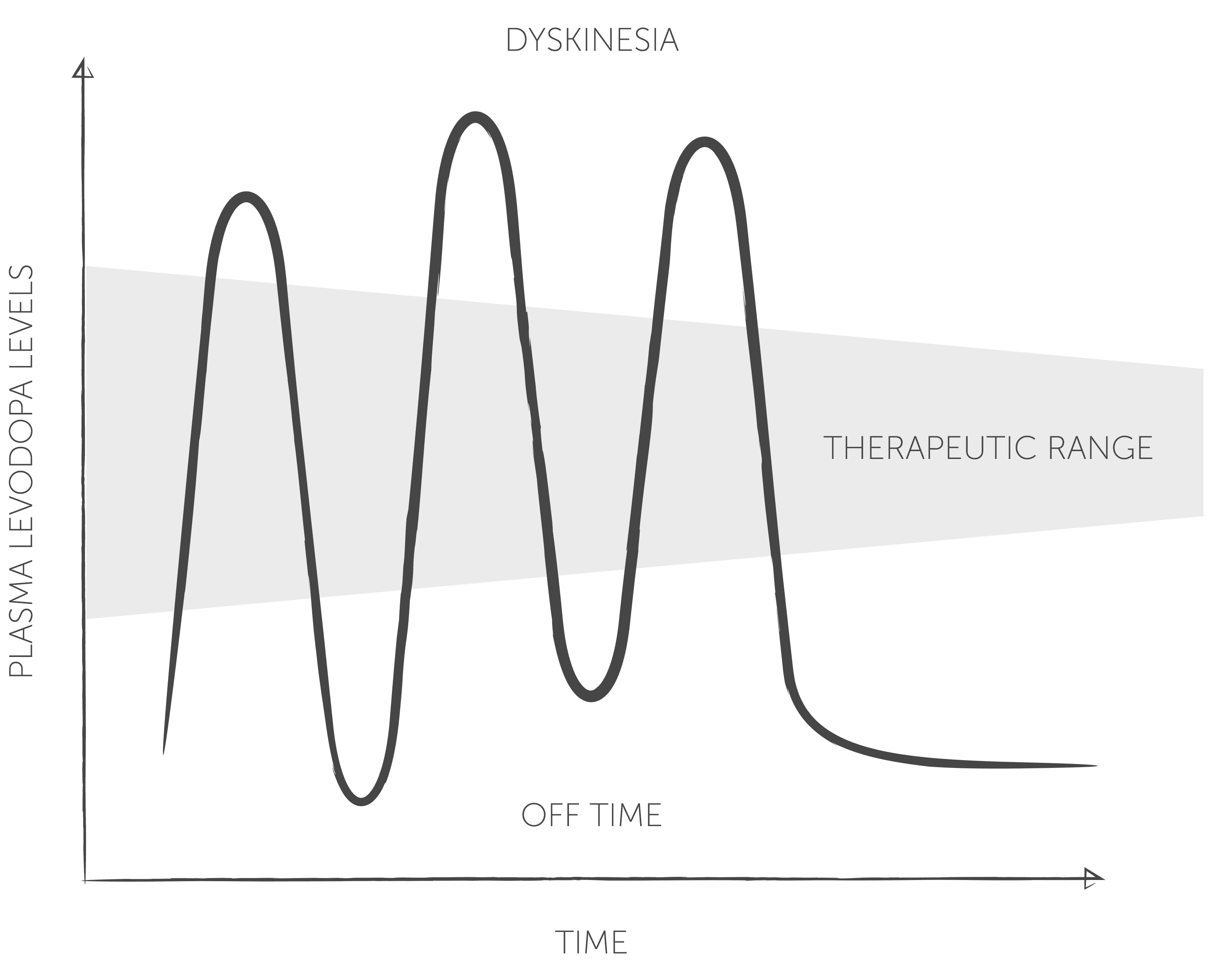IMPORTANT SAFETY
INFORMATION
CONTRAINDICATIONS
DHIVY is contraindicated in patients
- Currently taking a nonselective monoamine oxidase (MAO) inhibitor (e.g., phenelzine, linezolid, and tranylcypromine) or have recently (within 2 weeks) taken a nonselective MAO inhibitor. Hypertension can occur if these drugs are used concurrently.
- With known hypersensitivity to any component of DHIVY.
WARNINGS AND PRECAUTIONS
Falling Asleep During Activities of Daily Living and Somnolence: Patients taking carbidopa/levodopa alone or with other dopaminergic drugs have reported suddenly falling asleep without prior warning of sleepiness while engaged in activities of daily living (including the operation of motor vehicles), which has resulted in accidents. Although many patients reported somnolence while on dopaminergic medications, some perceived that they had no warning signs (sleep attack), such as excessive drowsiness, and believed that they were alert immediately prior to the event. Sudden onset of sleep has been reported to occur more than 1 year after the initiation of treatment.
Advise patients of the potential to develop drowsiness and specifically ask about factors that may increase the risk for somnolence with DHIVY, such as concomitant sedating medications and the presence of sleep disorders. Because some events may occur well after the start of DHIVY treatment, reassess patients for drowsiness or sleepiness and be aware that patients may not acknowledge drowsiness or sleepiness until directly questioned. Consider discontinuing DHIVY in patients who report significant daytime sleepiness or episodes of falling asleep during activities that require active participation. If treatment with DHIVY continues, patients should be advised not to drive and to avoid other potentially dangerous activities that might result in harm if the patients become somnolent. There is insufficient information to establish that dose reduction will eliminate episodes of falling asleep while engaged in activities of daily living.
Withdrawal-Emergent Hyperpyrexia and Confusion: A symptom complex that resembles neuroleptic malignant syndrome (characterized by elevated temperature, muscular rigidity, altered consciousness, and autonomic instability), with no other obvious etiology, has been reported in association with rapid dose reduction, withdrawal of, or changes in dopaminergic therapy. Avoid sudden discontinuation or rapid dose reduction in patients taking DHIVY. If the decision is made to discontinue DHIVY, the dose should be tapered to reduce the risk of hyperpyrexia and confusion.
Cardiovascular Ischemic Events: In patients with a history of myocardial infarction who have residual atrial, nodal, or ventricular arrhythmias, cardiac function should be monitored in an intensive cardiac care facility during the period of initial dosage adjustment.
Hallucinations/Psychotic-Like Behavior: Hallucinations and psychotic-like behavior have been reported with dopaminergic medications. In general, hallucinations present shortly after the initiation of therapy and may be responsive to dose reduction in levodopa. Patients with a major psychotic disorder should not be treated with DHIVY because of the risk of exacerbating psychosis. In addition, medications that antagonize the effects of dopamine used to treat psychosis may exacerbate the symptoms of Parkinson’s disease and may decrease the effectiveness of DHIVY.
Impulse Control/Compulsive Behaviors: Case reports suggest that patients can experience an intense urge to gamble, increased sexual urges, intense urges to spend money, binge eating, and/or other intense urges, and the inability to control these urges while taking one or more of the medications, including DHIVY, that increase central dopaminergic tone and that are generally used for the treatment of Parkinson’s disease. Because patients may not recognize these behaviors as abnormal, it is important for prescribers to specifically ask patients or the caregivers about the development of new or increased gambling urges, sexual urges, uncontrolled spending, or other urges while being treated with DHIVY. Consider dosage reduction or stopping the medication if a patient develops such urges while taking DHIVY.
Dyskinesia: DHIVY can cause dyskinesias that may require a dosage reduction of DHIVY or other medications used for the treatment of Parkinson’s disease.
Peptic Ulcer Disease: Treatment with DHIVY may increase the possibility of upper gastrointestinal hemorrhage in patients with a history of peptic ulcer.
Glaucoma: DHIVY may cause increased intraocular pressure in patients with glaucoma. Monitor intraocular pressure in patients with glaucoma after starting DHIVY.
Laboratory Tests: DHIVY may cause a positive Coombs test or false-positive reaction for urinary ketone bodies when a test tape is used for determination of ketonuria. This reaction will not be altered by boiling the urine specimen. False-negative tests may result with the use of glucose-oxidase methods of testing for glucosuria. Cases of falsely diagnosed pheochromocytoma in patients on carbidopa/levodopa therapy have been reported. Caution should be exercised when interpreting the plasma and urine levels of catecholamines and their metabolites in patients on carbidopa/levodopa therapy.
Depression/Suicidality: All patients should be observed carefully for the development of depression with concomitant suicidal tendencies.
DRUG INTERACTIONS
Monitor patients taking selective MAO-B inhibitors and DHIVY; this combination may be associated with severe orthostatic hypotension. Coadministration with dopamine D2 receptor antagonists, isoniazid, iron salts, or metoclopramide may reduce the effectiveness of DHIVY. Concurrent administration with antihypertensive drugs may result in postural hypotension, necessitating a dose reduction of the antihypertensive drug. Coadministration with dopamine-depleting agents is not recommended.
ADVERSE REACTIONS
The most common adverse reactions reported with carbidopa/levodopa tablets have included dyskinesias, such as choreiform, dystonic, and other involuntary movements, and nausea.
Please see full Prescribing Information.

